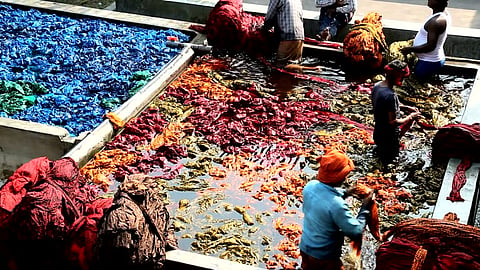Water Pollution in the Textile Industry: An Urgent Call for Sustainable Innovation
Introduction
The textile industry stands at a crossroads. Once celebrated solely for driving exports and employment, it is now under global scrutiny for its environmental footprint — particularly in water pollution. For business leaders and scientific professionals, addressing this issue is no longer just a moral obligation but a strategic imperative tied to compliance, competitiveness, and reputation.
As international markets tighten environmental standards, sustainable water management in textiles has become the defining factor for long-term success.
The Hidden Cost of Fashion: A Water Crisis in the Making
Producing fabrics and garments consumes vast quantities of water and releases a toxic mix of dyes, salts, and chemicals into local ecosystems. The dyeing and finishing processes, in particular, are notorious for generating wastewater that is difficult to treat and detrimental to aquatic life.
In India’s textile hub Tirupur, these consequences became alarmingly visible two decades ago when the Noyyal River turned into a chemical drain. The crisis triggered a series of regulatory actions, leading to the establishment of Zero Liquid Discharge (ZLD) systems and Collective Effluent Treatment Plants (CETPs). Today, Tirupur stands as a global model for sustainable industrial water practices — proving that economic success and environmental responsibility can go hand in hand.
Global Trade Shifts: USA’s Tax Policies and Bangladesh’s Setback
Recent developments in international trade have made environmental compliance a decisive factor in textile exports. The United States’ new tax implications linked to sustainability performance and import restrictions on Bangladesh due to environmental non-compliance have reshaped the regional textile landscape.
These policy shifts have affected Bangladesh’s export-dependent economy, creating opportunities for Indian manufacturers to capture displaced demand. With its established water treatment infrastructure and growing adoption of renewable energy in production, India is emerging as a preferred sourcing destination for global brands prioritizing ESG standards.
Bangladesh’s Loss Is India’s Gain?
While Bangladesh grapples with environmental and trade challenges, Indian clusters — particularly Tirupur, Surat, and Ludhiana — are seeing increased global interest. However, India’s advantage will remain sustainable only if the industry continues to innovate, invest, and comply.
International buyers are now demanding traceability in wastewater management, eco-certified dyes, and recycled water usage metrics. Tirupur’s journey demonstrates that consistent environmental commitment builds credibility and competitiveness — qualities that buyers now reward with long-term contracts.
From Compliance to Innovation: Building the Green Textile Future
The next phase for the textile industry lies in transformative innovation, not just regulatory adherence. Key focus areas include:
Advanced Treatment Systems: Adoption of membrane bioreactors (MBR), reverse osmosis (RO), and nanofiltration (NF) for high water recovery and reuse.
Eco-friendly Dyes and Enzymes: Transition to low-impact chemicals and natural dyeing alternatives.
Digital Water Management: Real-time monitoring and AI-driven optimization of water usage and discharge quality.
Cluster-Based CETPs: Shared facilities that make sustainable compliance economically viable for MSMEs.
Public-private partnerships and government incentives must further support this transition, ensuring cleaner, more efficient, and globally competitive textile operations.
Conclusion: Turning Water Challenges into Business Opportunities
The textile industry’s transformation is not just about pollution control — it’s about future-proofing an entire sector. Bangladesh’s current struggles serve as a warning, while Tirupur’s resurgence highlights the rewards of proactive sustainability.
For Indian textile businesses, the message is clear: sustainability is the new driver of growth. Cleaner production practices, transparent water management, and sustainable innovation are no longer optional — they define the brands that will thrive in the coming decade.
To explore advanced wastewater treatment systems, circular water technologies, and sustainable dyeing innovations, visit the upcoming Water Expo Chennai, where over 200 companies and 6,000+ professionals converge to shape the future of industrial sustainability.

